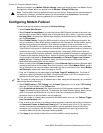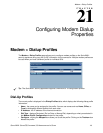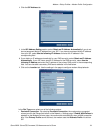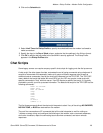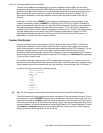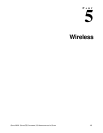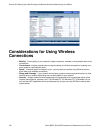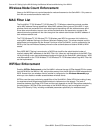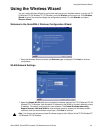124
SONICWALL SONICOS STANDARD 3.0 ADMINISTRATOR’S GUIDE
C
HAPTER
21:
Configuring Modem Dialup Properties
The next line has OK as the expected string, and the interpreters waits for OK to be returned in
response to the previous command, ATV1, before continuing the script. If OK is not returned within
the default time period of 50 seconds, the chat interpreter aborts the script and the connection fails. If
OK is received, the prefix and phone number of the selected dial-up account is dialled. The \T
command is replaced by chat script interpreter with the prefix and phone number of the dial-up
account.
In the last line of the script, CONNECT is the expected response from the remote modem. If the
modems successfully connect, CONNECT is returned from the TELE3 SP modem.The \D adds a
pause of one second to allow the server to start the PPP authentication. The \C command ends the
chat script end without sending a carriage return to the modem. The TELE3 SP then attempts to
establish a PPP (Point-to-Point Protocol) connection over the serial link. The PPP connection usually
includes authentication of the user by using PAP (Password Authentication Protocol) or CHAP
(Challenge Handshake Authentication Protocol) from the PPP suite. Once a PPP connection is
established, it looks like any other network interface.
Custom Chat Scripts
Custom chat scripts can be used when the ISP dial-up server does not use PAP or CHAP as an
authentication protocol to control access. Instead, the ISP requires a user to log onto the dial-up
server by prompting for a user name and password before establishing the PPP connection. For the
most part, this type of server is part of the legacy systems rooted in the dumb terminal login
architecture. Because these types of servers can prompt for a user name and password in a variety of
ways or require subsequent commands to initiate the PPP connection, a Chat Script field is provided
for you to enter a custom script.
If a custom chat script is required by an ISP for establishing a connection, it is commonly found on
their web site or provided with their dial-up access information. Sometimes the scripts can be found by
using a search engine on the Internet and using the keywords, “chat script ppp Linux <ISP name>”.
A custom chat script can look like the following script:
ABORT `NO CARRIER'
ABORT `NO DIALTONE'
ABORT `BUSY'
" ATQ0
" ATE0
" ATM1
" ATW2
" ATV1
OK ATDT\T
CONNECT "
sername: \L
assword: \P
9
Tip: The first character of username and password are ignored during PPP authentication.
The script looks a lot like the previous script with the exception of the commands at the end. There is
an empty string (") after CONNECT which sends a carriage return command to the server. The chat
interpreter then waits for sername: substring. When a response is returned, the current PPP account
user name, substituting the \L command control string, is sent. Then, the chat interpreter waits for the
substring assword:, and sends the password, substituting \P with the PPP account password. If either
the sername or assword substring are not received within the timeout period, the chat interpreter
aborts the dial-up process resulting in a dial-up failure.



